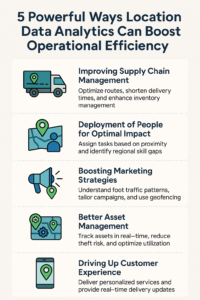As the digital landscape continues to evolve, businesses now search for quicker ways to improve their efficiency. Location analytics is one of the most powerful tools they have in their arsenal. Using the information revealed by geospatial data, organizations can make better decisions, refine their processes, and even increase productivity. Here are five powerful operational efficiency changes you will get out of location data analytics. Let’s find out in detail.
Improving Supply Chain Management
Supply chains are intricate systems that must function in perfect harmony. By providing visibility into the movement of goods, businesses can leverage location data analytics to optimize routes and shorten delivery times. Analyzing traffic patterns and weather conditions enables firms to predict potential delays and adapt distribution strategies in advance. These proactive measures not only reduce costs but also improve customer satisfaction. Additionally, location data enhances inventory management by tracking the real-time flow of goods, ensuring stock levels align with consumer demand. This minimizes overstocking and stockouts, driving resource optimization and cost savings.
Deployment of People for Optimal Impact
Maximizing workforce productivity is essential for organizational success, and leveraging location data plays a crucial role in achieving this. By analyzing employee movement patterns, businesses can optimize task assignments based on proximity to job sites, minimizing travel time and allowing employees to dedicate more hours to actual work. Additionally, understanding peak traffic times and regional dynamics helps to allocate resources more efficiently, reducing downtime. Beyond logistics, location data also reveals regional skill gaps, enabling companies to identify areas where targeted training is needed.
By providing tailored skill development programs to employees in specific regions, businesses can enhance their workforce’s abilities and meet job requirements more effectively. This strategic use of location data not only improves operational efficiency but also fosters a more competent, motivated, and adaptable workforce, ultimately leading to higher productivity and better business outcomes.
Boosting Marketing Strategies
To craft successful marketing campaigns, understanding consumer behavior is crucial. Location data analytics reveals valuable insights into foot traffic patterns and demographics, enabling businesses to tailor marketing strategies to specific customer segments. Geofencing, which involves setting virtual boundaries around areas, allows companies to send customized promotions to potential customers when they enter the designated zones. By fine-tuning their targeting, businesses can engage the audience most likely to convert. Monitoring competitors’ foot traffic also offers a glimpse into market trends, giving companies a competitive edge.
Better Asset Management
Effective asset management is key to business success. Location data analytics offers real-time tracking of assets, reducing theft and loss. By monitoring the location of equipment and vehicles, organizations can optimize asset utilization and schedule maintenance more effectively. Predictive maintenance powered by location data also enables companies to foresee potential breakdowns by analyzing usage trends and environmental factors. This approach minimizes operational downtime, boosts productivity, and extends the lifespan of valuable assets.
Moreover, by maintaining visibility over asset movement, businesses can reduce inefficiencies, enhance security, and make more informed decisions regarding asset deployment. With detailed data on asset conditions and usage, companies can ensure that resources are always in the right place at the right time, further improving operational efficiency. Through these insights, businesses can streamline processes, improve cost-efficiency, and increase the return on investment for their physical assets.
Driving Up Customer Experience
How does location data analytics enhance the customer experience? By understanding consumer preferences and behaviors, businesses can offer more personalized services, increasing customer loyalty and satisfaction. Real-time location data ensures seamless service delivery, such as providing precise delivery arrival times or dispatching technicians who are nearest to the customer. These efforts not only improve the customer experience but also strengthen brand goodwill.
Conclusion
Leveraging location intelligence to gain actionable insights gives businesses a competitive edge in today’s market. From optimizing supply chains to enhancing customer experience, location data analytics supports data-driven decisions that drive cost efficiency and operational effectiveness. As technology evolves, the demand for location data analytics continues to rise, solidifying it as a vital tool for forward-thinking businesses.

